

Not very long ago, in a lower corner of Wales, there was a railway.
It wasn't a very long railway or a very important railway, but it was called The Merioneth and Llantisilly Rail Traction Company Limited, and it was all there was. And in a shed, in a siding at the end of the railway, lives the Locomotive of the Merioneth and Llantisilly Rail Traction Company Limited, which was a long name for a little engine so his friends just called him Ivor.
Now in the morning, Jones the Steam, the engine driver, would come down over the hill. He would take wood and paper, and light Ivor's fire, fill up his coal box, check the water, then when Ivor had steam-up, he would make his pot of tea, and sit on Ivor's step to drink it... "Oh right, we'd better do some work I suppose!"
Ivor the Engine, there he goes look. Psst-ee-couff, psst-ee-couff, psst-ee-couff!
Just an ordinary looking steam engine. You'd never think to look at him he's got a dragon in his firebox!
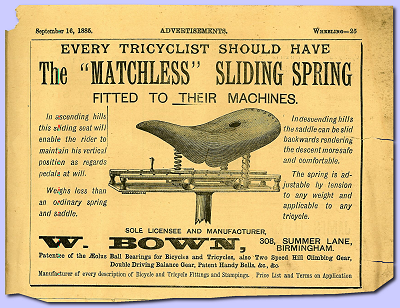
Bown advertisement from 1865
"Since 1860" it says on the badge, "South Wales" ... but, back in the Victorian age, this tale begins in Birmingham, with the engineering of parts for sewing machines and hair clippers, roller skate wheels in 1876; Aeolus ball bearings in 1879; and the brief appearance of Aeolus motor cycles in 1914 - produced by a certain Bown Ltd.
The Aeolus brand disappeared in 1916, though the very same machines returned to the market after the Great War under Bown's own badge. Bown continued building motor cycles until the mid 1920s, when the business relocated to Chadwell Heath in Essex and turned to the manufacture of specialist bicycles. Around halfway through the 1930s, the Bown Company was acquired and became absorbed into the Aberdale Cycle Co, based at Bridgeport Road, Edmonton, North London, and W A R Bown retained a seat on the board in a technical role, allowing its owners, the Levy brothers, to concentrate on management of the commercial side of the business.
During World War Two, the Aberdale plant was turned over to the production of war materials, including the building of a small generating engine set for use on aeroplanes. With a return to peace in 1945, came a renewed demand for economic personal motorised transport - and the autocycle was now poised for its big moment!
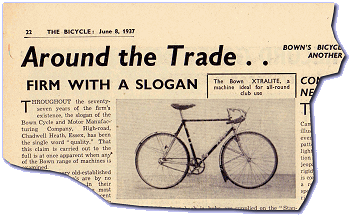
1937 Bown Xtralite bicycle
As other cycle manufacturers successfully returned to the market with pre-war autocycle models, the shrewd Levy brothers saw new opportunities opening up. Designed by W A R Bown, and powered by the Villiers Junior de Luxe motor, the Aberdale autocycle appeared out of the blue, and was first reviewed by Motor Cycling on 6 March 1947.
Autocycle technology was moving on rapidly after the war, with Villiers announcing the 2F replacement for the JDL to its customers late in 1948, and Aberdale was right there with Francis-Barnett, New Hudson, Norman and Sun, in showing their new 2F-powered prototype at the Earls Court Show in November. Price listings at this show presented the JDL Aberdale as the cheapest autocycle at £50-9s-4d, the nearest competitor being New Hudson's outgoing JDL model at £53-6s-10d. However, while much of the competition was delivering its new 2F machines out for sale in the 1949 season - the new Aberdale was nowhere to be seen! Instead, the old JDL model was called upon to soldier on for another year, and further publicity pictures appeared of the original autocycle trimmed with a new pattern of engine-panels.

1949 Aberdale JDL autocycl
The first clue to this puzzle appeared as a short passage in the Rhonda Leader newspaper of 29 January 1949, about "The establishment of a cycle manufacturing concern at one of the two unoccupied factories on the Partridge tip site, Llwynypia". Aberdale's production of their latest autocycle had become distracted by the setting up of this new plant under the Labour government's 'Advanced Factory Scheme', so the old JDL machine continued to be assembled back at Edmonton while the Tonypandy factory was being equipped to supply the new 2F model to market for the 1950 season.
The new South Wales plant came to be titled as the Bown Cycle Co Ltd and, when the 2F autocycle eventually re-appeared in a review by The Motor Cycle of 16 February 1950, it had acquired a set of engine covering side panels, the tailpipe exhaust had become a silencer box between the lower frame rails, and it was now branded as the new Bown Auto-Roadster!
Listed for just 2½ years, the Aberdale JDL autocycle was finally withdrawn at the end of the 1949 sales season with certainly fewer than 2,000 examples having been built, and frame number AAU 1328 being the highest serial so far noted in machine register records. Bown branded autocycles seemed to continue the same numeration series with a BAU prefix.
Frame serials for the new Bown 98cc 'Standard' Motor Cycle are first represented from BMC 1001 in 1951, then a new series starting from BLM 1 would appear to have been commenced for 1952 at engine number 716-18723. From February 1952, Glass's Index indicates the addition of a fully fitted 'de Luxe' 98 Motor Cycle version, with Lucas rectified lighting, battery and ammeter, rear carrier, leg shields and splash guard.
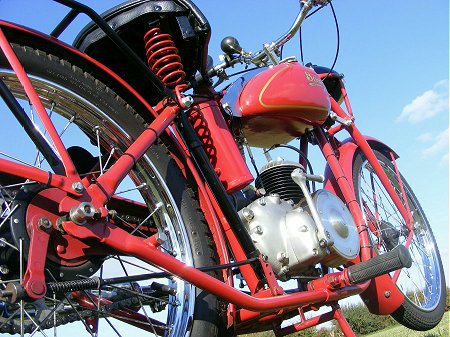
One of the first puzzling questions might be why Bown may have chosen to present the new motor cycle as 98cc, when the Villiers 1F and 2F engine types were actually 99cc? Perhaps it was trying to maintain some continuity from the previous generation of autocycles? Another question that may be pondered upon is the title of this article?
Well ... if you haven't guessed it yet, in the stories of Oliver Postgate, Idris was a small, heraldic, Welsh red dragon, hatched from an egg in the firebox of Ivor the Engine; which association seems quaintly appropriate for our own feature machine, being a small, Welsh-built motor cycle, finished in bright maroon with gold coach trim.
The Bown 98 motor cycle provides an interesting comparison with its autocycle stablemate, since you'd probably be expecting many shared aspects between the two machines, but in fact they have few common parts! Both models feature duplex cradle frames, but here the similarity ends, as the respective chassis are completely different designs. The autocycle wears a pressed steel Webb girder fork set up front, where the motor cycle mounts a tubular Webb girder set, which was also employed by Excelsior, Sun, New Hudson and others. Instead of the autocycle 'long' tank, the motor cycle tank visually appears fairly conventional, but closer examination rewards the curious. Investigation of the twin filler caps reveals the 'tank' actually comprises two separate halves that are barely joined by a thin bridge at the bottom, so that when you fill the tank on one side, you have to remove the cap on the other segment to vent the air! Since the tank mounts from underneath the frame tube, the unsightly gap between the segments is covered across the top by a fitted chrome strip. While this arrangement allows the top of the tank to be mounted pretty much flush with the top frame tube, it's hard to see any real benefits in the design, and probably only serves to increase complication and cost.
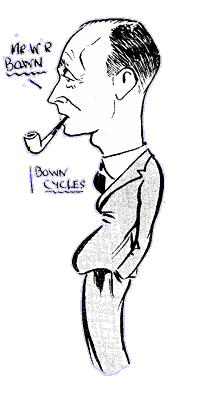
Retained by a ball clip, the cylindrical toolbox is another individual oddity, as the canister swings out from the frame line on a couple of pivots to allow access, when the top can be removed. The exhaust pipe is another striking example of convoluted engineering, with no fewer than four distinct bends over its 31-inch length.
Very typically of W A R Bown, there's no question about the quality of any of the engineering, but considering the machine was also expected to be commercially competing in the same group with the ABJ, Bond Minibyke, Excelsior Consort, James Comet, Norman Model D, and Sun Hornet, then the quality engineering of the Bown may have been rather working against its competitive pricing, so the profit margin might have been squeezed a little.
Seemingly dating from 1952, our featured machine carries frame serial BLM 519, and engine number 716-17812. It wears a rear carrier in non-colour matching black finish since this component was purchased as an accessory for 17s-6d. A speedometer kit was also a listed accessory for £3-10s, but is not fitted to our mount, so the pace bike accompanies our ride once again.
Petrol tap mounts under the left hand tank segment then, avoiding the call of temptation from the inviting flood button on Villiers's own 6/0 carburetter, we choose instead to shut the air filter strangler, and a just couple of jabs at the kick-start rewards our considered decision. The strangler can be readily opened, and the bike is ready to ride in a moment.
The modern pattern silencer is considerably more heavily baffled than the original Burgess that the period tests criticised as 'raucous and obtrusive'. While the Armours reproduction system now very effectively stifles the sound the period testers of nearly 60 years back greatly desired to silence, it may also appear to constrict the gas release, as the system seems to pressurise, readily driving smoke to escape from system joints at the cylinder and exhaust pipe. A brief burst in first gear was indicated at a maximum 27mph by the pace bike. Comfortable cruising in second (top) was found around 32, and best on flat clocked up to 36mph, though it would probably prove capable of building up to a little more under favourable conditions. The downhill run paced a creditable 43, and charging the uphill climb on the other side, crested the rise still holding 30mph.

Though cumbersome to operate, the handlebar trigger-shift works pretty smoothly on this machine as long as you don't try to hurry it too much. The change lever is closely mounted to the twistgrip, so you can switch up and down the gears using your finger or thumb without actually needing to remove your hand from the throttle. Probably considered an improvement on the old hand-change lever on the side of the petrol tank, where you had to take your right hand away from the bar for any gear shift, the handlebar mounted trigger change is really just an in-between arrangement to the much more practical and obvious progression to foot-change gears on the later 6F motor. The rear footbrake lever is conventionally positioned British style for the period, on the left hand side, with a 'B' engraved in the pedal face - might that be for Bown or brake? A crossover shaft runs from the lever to a rod linkage operating the drum brake on the right side, while the final drive runs to the sprocket on the left side. Sun also used this separate drum brake arrangement on their Hornet light motor cycle, but Sun unconventionally located their brake pedal on the right to economise on the linkage - Bown and Norman properly positioned their brakes on the left! Performance of the brakes proved effective enough within the capacity of the machine, though there probably wouldn't prove much stopping to spare in case of an emergency.
The Webb front suspension worked well and absorbed enough from the road that the rider observed no adverse surface effects during the run. The sprung saddle also dampened any motion from the rigid rear frame, and only a small level of low frequency engine vibration could be felt through the footrests, so general comfort around the course proved very good.
Certainly some improvement on the typical autocycle 3-inch flat-back headlight, the bigger 4½-inch Lucas headlamp seems to make slightly better use of the output from the same feeble magneto generator, which may look impressive with its big whirling brass flywheel, but struggles to produce enough energy to even worry the 12/12 Watt beam/dip headlamp bulb. Considering the better performance available from the 2-speed motor cycle, the resultant illumination is still limited by the same number of electrons and is absolutely no better at all to navigate by down dark country lanes.
1953 saw both the Standard and de Luxe motor cycles installed with the 4F engine to replace the original 1F, and an electric horn now fitted to the de Luxe.
Tube Investments notified acquisition of the Aberdale Cycle Co Ltd in October 1954 and its product licences progressively became absorbed as part of the British Cycle Corporation portfolio. Badly affected by the dramatic decline of the autocycle market in the early 1950s, the poor sales of the lightweight motor cycle models were insufficient to economically maintain the factory. The plant in Wales closed over the winter of 1954/55, and its Bown branded products were discontinued.
Aberdale returned again at the Earls Court Show in November 1955, with a factored Zweirad Union moped under the Bown brand, assembled back at Edmonton, London. The last Bown mopeds were built out during 1958, though continued on listings into 1959 to clear remaining stocks. This was to be the final year and the Bown brand never quite made its centenary.
The Aberdale directorships were formally relinquished in January of 1959, and on 27 February it was advised "The business of the Aberdale Cycle Co Ltd. has transferred to Britannia Works, Handsworth, Birmingham 21, as part of the new buildings of the British Cycle Corporation" (sharing the address with Hercules and James Cycles at the former site of Brampton Fittings Ltd).
This wasn't, however, the end of the road for the partnership of the Levy brothers and W A R Bown who, along with several of their former colleagues from Aberdale, registered The Trusty Manufacturing Co Ltd at Angel Factory Colony, Edmonton, London N18, making the Trusty Pavemaster children's scooter and a range of juvenile Trusty Pavement Cycles.
A small passage by Joe Levy appeared in a May 1964 edition of Motor Cycle & Cycle Trader magazine, stating that William A R Bown had retired from the business in 1961.
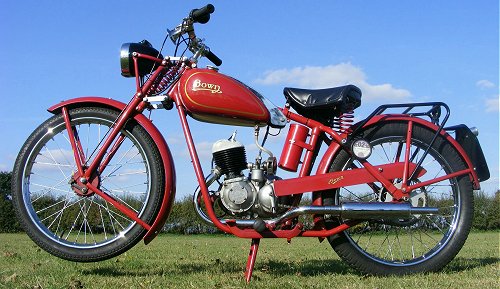
Next - Following the 'smaller' aspect to our next edition, the 1960s seemed to be the decade of the Mini. The word was probably a derivation of 'miniature', and did the term come into being when Alec Issigonis produced his famous Mini car design for BMC in 1959? Soon the age of the Mini skirt was upon us, or barely upon all the young ladies that took to wearing the fashion of this time.
Probably producing less of an impact than the Mini car, and certainly less socially controversial than the Mini skirt, the moped world gets its own little slice of the action in 1966 with our forthcoming Mini 16 feature. This brief glimpse of future-past is simply coming down to a trend for smaller wheel sizes.
[Text and photos © 2011 M Daniels. Period documents from IceniCAM Information Service. Ivor the Engine illustrations from The Smallfilms Treasury.]
The Bown 99cc light motor cycle is the third of our featured machines from the Colin Clover collection.
It's taken as read that any of William A R Bown's machines are going to be well-engineered and nice riding vehicles, and our feature bike didn't let the side down. Bown were certainly among the best quality machines in their class, and it doesn't take long in the saddle to appreciate these autocycles and motor cycles are a cleaner cut above many similar bikes from other manufacturers.
Along with Colin's Sun Hornet, the Bown was road tested and photoshot back in February 2010.
We got a nice bright day for the pictures, with clear blue skies, but it was still pretty cold.
There was no target publication planned for the Idris article, so just a routine case of banking another feature for some future date... All well ahead of the game ... until just a couple of months later when the editor of The Independent, the BTSC magazine, is calling up, wanting two article packages delivered for editing to publication before Danny flies off to Cyprus in the next two weeks!
After earlier having run a newly re-written Elswick-Hopper Lynx Project in two parts, and The James Gang, we mentioned to the BTSC editor that we had some 'light motor cycle' articles in the pipeline, which they may be interested in for "sometime in the future" ... but it seems that submissions for forthcoming editions were suddenly found to be 'unexpectedly light', so they would like to call a couple of these off 'rather sooner', if that might be alright please?
The particular articles being called off were the Sun Hornet and Bown features, and neither were anywhere near being presentable for publication.
This did create a little unplanned excitement (blind panic) in the writing department, resulting in an emergency 'drop everything else' to complete and deliver A little Sunshine in one week, and the new Bown article Idris the following week.
For quite a while now, IceniCAM has been licensing out a whole bunch of our articles to several other publications, the Moto-Guzzi Club Magazine, Gambalunga; Vintage Motor Scooter Club Magazine; RumCars (Register of Unusual MicroCars); The Radial, Rudge Owners Club magazine; Priory Press, Ipswich Transport Museum magazine; Tansha, Vintage Japanese Motorcycle Club magazine; Nacelle, Triumph Owners Club magazine...
As some consolation, both the Sun and Bown features made the front cover of The Independent and also became their main feature across the colour centre pages of the respective editions, so a nice result, but yet again it meant we'd put out an article with another publication before running it in our own magazine, which isn't quite going according to plan.
Despite repeating the same title as the BTSC article, the IceniCAM version received a fair degree of rewriting, and carried quite a bit more reference detail, as well as our signature story-style additions to the intro and exit text.

See The Smallfilms
Treasury for more about Ivor the
Engine.
For anyone eccentric enough to be interested in further background as to where the Idris title came from, the article was called after Idris Bach, a small, red heraldic dragon from series of quaint and imaginative illustrated Ivor the Engine stories by Oliver Postgate.
Hatched from an egg in Ivor's fire, Idris sang in the local choir for a time, and lived with his lady dragon Olwen, and their twins Gaian and Blodwyn in the extinct volcano, Smoke Hill.
As well as singing, he once proved useful by cooking fish and chips for the choir using his fiery breath.
Unfortunately, Idris ran into trouble when Smoke Hill went cold - he needed to be kept hot in order to survive. The gas board provided a temporary furnace, but when that became too expensive (and decimalisation rendered the slot machine inoperable), the only other option for the dragons was a heated cage. Luckily, Mr Dinwiddy was able to provide a solution, and the dragon family moved to live in a geothermally-heated cave under the ground.
By the wonders of modern technology, many of the classic Ivor the Engine stories are freely available to view and enjoy on YouTube.
Anyway, back to bikes...
There's probably more to come from the Clover collection. Colin has further smart and interesting light motor cycles to which he's offered us access, so it's likely we'll shortly be testing further samples for future presentations.
Production costs for Idris were pretty moderate, simply a there-and-back trip to Leiston to collect and return the bike, so just around about £10 in diesel fuel.
Looking through sponsorship donations still on the credits list just happened to be a ten-pounder from Tom Garnham. Tom is a new local contact who initially came to us after dating services for registration, then some parts, and later we ended up running his Raleigh Runabout through the workshops to resolve its running issues.
There's certainly more to what we do than just a website!